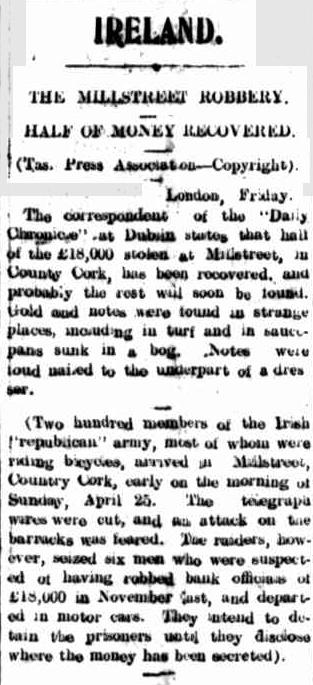 Following on from some recent discussion into the execution of Daniel Buckley near Millstreet in 1920, the background to his fate lies in the Millstreet Bank Robbery of 1919. Below is the 2011 publication by the Aubane Historical Society which outlined the before, during and the after of the robbery:
Following on from some recent discussion into the execution of Daniel Buckley near Millstreet in 1920, the background to his fate lies in the Millstreet Bank Robbery of 1919. Below is the 2011 publication by the Aubane Historical Society which outlined the before, during and the after of the robbery:
INTRODUCTION
The Millstreet bank robbery of November 17th 1919 was a sensational event. It involved an enormous sum of money for the time – £16,700 – which would be worth at least half a million Euro today. (The average farm labourer’s weekly wage was then £1.10s.6d.).
But more importantly it created a real challenge for the new Irish government that had been formed earlier that year. There were then two governments in the country – the new legitimate Irish Government and the now illegal British government that had been rejected overwhelmingly in the 1918 General Election.
There was a full scale war developing between the two. Part of this war was a propaganda war and the robbery was used by the British Government as an example of what would allegedly happen if the Irish Government was allowed control of the country. It was even freely suggested that the robbery was carried out by the Irish Government.
All this made it imperative for the new Government to assert its authority, clear its name and gain the confidence of the people so that they could be trusted with law and order and the maintenance of good and fair government.
Liam Lynch moved into Drishanebeg to supervise the investigation and presided at the court that heard the case and made the convictions. The recovered money was returned to the Bank. Lynch was praised by Collins for a job well done. The solving of the case was very significant as it made the new Government credible, trustworthy and effective in running the affairs of the country. Its reputation was enhanced immeasurably destroying the negative propaganda campaign against it by the British authorities.
This pamphlet tells the story of how it was done and the report is taken from the files of the Irish Bulletin which was the official paper of the Irish Government from 1919 to 1921. It was set up after all Republican press outlets were suppressed and the new Irish government needed to make information about the War of Independence available and to put its case for independence to the world. Hence the paper was aimed mainly at audiences abroad to make them face up to what was actually happening in Ireland.
It was edited by Erskine Childers and Frank Gallagher. The latter began his journalistic career with the Cork Free Press and was the first editor of The Irish Press. The Bulletin was very successful and seriously upset the propaganda efforts of the British Government at home and abroad.
At one stage (20/3/1921) its place of operations was accidently discovered over an Easter holiday when no staff were present. Every single bit of machinery, equipment, paper, ink, envelope and address list were taken to Dublin Castle and used these to produce forged issues for about a month. This was testimony to how successful it had been at countering the Castle’s propaganda. The Bulletin itself was re-established almost immediately and continued its work.
The other items in this pamphlet are also from the Bulletin and are local examples of the behaviour of the Crown forces toward the civilian population. The first is a statement by the caretaker at Drishane Convent on how he was treated after the nearby Drishanebeg (or Glebe) ambush. The second is a statement by Daniel Dineen on the killing of his brother, Mikie Dineen, of Ivale which occurred during the Mushera Round-up following the Rathcoole ambush. The third item describes a very typical raid by Auxiliaries on the Dennehy home in Millstreet..
Jack Lane
January 2011
—-
VOLUME 2. No. 32. Irish Bulletin, 15th. June 1920
A REPUBLICAN CAUSE CÉLÈBRE
REMARKABLE STORY OF A DARING BANK ROBBERY
How a Gang of Thieves were Rounded Up by Republican Police
The following is the first accurate account to be made public of the recent Bank Robbery which took place at Ballydaly Cross near Millstreet, County Cork, and was one of the most sensational of modern bank robberies. The account is written from the official Republican records and discloses for the first time the details of the arrest, trial, and sentences of the gang that carried out this audacious theft of £16,700. The discovery of the identity of the robbers and their subsequent arrest is one of the most remarkable achievements of the Irish Republican Police.
Nor is it a less sensational feature of the occurrence that the gang were not interfered with by the British Police or any efforts made by that force seriously to enquire into the circumstance of the robbery or to trace the robbers. The cause for this inactivity will be better understood when it is mentioned that in the first instance the Republican movement was by official propaganda saddled with the guilt of the crime. In accordance with this official British view the investigations of the British police in connection with the occurrence were restricted, first in an effort to suborn evidence implicating a member of the Republican Government of Ireland in the robbery and secondly an endeavour to track down those Republicans who engaged themselves without payment in the unravelling of this mystery and in the dispersal of the dangerous gang whose handiwork it was.
The incidents here related are an example of the ability with which the Irish people, without assistance from any British institution, preserve law and order in Ireland, detect crime and inflict salutary punishment upon criminals. The names of witnesses and of judges are suppressed in this account as, were they given, these witnesses and judges would themselves be liable to arrest by British police.
THE ROBBERY.
On November 17th. 1919 the representatives of the Munster and Leinster Bank and of the National Bank left Millstreet, County Cork at 8 a.m. to attend a cattle fair at Knocknagree in that county. They carried with them £16,700 in notes and silver. The officials of the National Bank drove in a jaunting car and those of the Munster and Leinster Bank followed in a motor car owned and driven by Patrick Carmody of Millstreet. When the jaunting car was some three miles from the town of Millstreet, five men armed and disguised suddenly appeared on the road and holding up the occupants deprived them of the £6,700 they carried. The five men then loosed the horse from the car and having bound the bank officials to a tree returned to the road to await the arrival of the other bankers.
When the motor car was heard approaching, the jaunting car was used to block the road, and the second “hold up” took place and an additional £10,000 was stolen. Patrick Carmody, the motor driver, was, as were the bank officials tied to a tree, and the steering gear of the car destroyed. The robbers then disappeared. Half an hour later the victims succeeded in freeing themselves and at 9 o’clock they returned to Millstreet and reported the robbery to the British police, who did not even visit the scene of the occurrence but announced later that day they could find no trace of the robbers. No effort was spared by the British press and British politicians to advertise the fact that the robbery was committed by Sinn Fein and on that plea Patrick Carmody was two months later awarded £300 compensation by a British judge for the damage to his car.
THE REPUBLICAN POLICE INVESTIGATE
It was obvious from the action of the British police after the robbery had been reported to them that they were reluctant to trace the real culprits. As the thieves were allowed to by the British police time to cover their traces completely, the task of establishing their identity seemed hopeless. It was, however, undertaken by the Irish Republican police acting under the authority of Dail Eireann, the Republican Government of Ireland. Progress was slow. The mystery seemed insoluble. But eventually a clue was discovered and it was seen that great caution would have to be taken, as the gang, if they got any inkling of the discovery, would leave the country taking with them the huge sum of money they had stolen. Finally the moment came for striking. Evidence had been secured establishing the identity of every member of the gang, and warrants, of which the following is a copy, were issued against them:-
“Headquarters,
Millstreet Battn.,
24th April 1920
To ……………………..
I ………………… being the officer for the Millstreet area responsible for the lives and property of all Irish Citizens, hereby arrest you on the charge of having (with others) waylaid and robbed certain Bank Officials on the morning of November 17th.
As the enemy police (Royal Irish Constabulary) have aided and abetted this outrage instead of tracking down the culprits, it is my duty to the public, until such time as the Irish Police Force is established, to capture and punish the robbers in this particular outrage, which is only one of many carried out at this period when Irishmen are making the final struggle for Independence.
Signed …………………..Commander, Millstreet Battn.”
THE ARRESTS
At 10 o’clock p.m. on April 24th 1920, five months after the robbery, fifty armed Republican Police assembled at the town of Millstreet, and scouts were placed to watch the houses of the robbers. These scouts reported that three of the men were in their residences but the fourth, the man most wanted, was at a concert in the Town Hall. The arrest which was timed to take place at 10.30 p.m. was postponed until the concert had concluded. After 11 o’clock the Republican Police took position of the streets of the town. Some of them, by means of a cordon, isolated the two houses in which the suspects were, while others forced an entry into them and arrested Jerh. and Cornelius Buckley and P. Carmody of Main Street, Millstreet, three of the four men.
To the dismay of the Republican Officer in charge the missing man was found to be Daniel Buckley, Main Street, and the ringleader. The three captives were promptly blindfolded and bound, and were placed in a waiting motor car. As the car was about to be driven away a man was seen to be walking n the direction of one of the raided houses. The man was Daniel Buckley. Two minutes later, after a short struggle, he was taken into custody.
At the same time other Republican police were engaged in similar operations in neighbouring districts, where four others of the gang, Michael O’Connor, Coolihane, (Coolykerane, J.L.), Michael Murphy, Liscreagh, James Cotter, Mill Lane and Denis Sullivan, were arrested. In a third locality, at Nadd, other bodies of Republican police raided the residence of Daniel and Hugh O’Brien, brothers, the remaining two of the thieves known to have played a prominent part the robbery.
The arrest of the O’Briens was, however, not effected. The motor car carrying one party of Republican police whose duty it was to surround the O’Brien’s house, broke down, and during the delay thus caused these men escaped. The eight prisoners were then brought to a Republican prison and having been fed, were left under a strong guard during the night.
SILENT ROBBERS
At 4.15 a.m. on Sunday morning, April 25th, the eight accused were brought individually before a preliminary court, and each was closely questioned. Each denied absolutely his complicity in the robbery and after an examination lasting several hours, the men were put back into their cells.
WITNESSES WHO FEAR BRITISH POLICE
Later on that day, in response to information that British troops and police were seeking to discover the whereabouts of the prisoners in order to liberate them, the guard was doubled at all points. It was then decided to hand the men over to the Banks from which the money had had been stolen and to place these banks in possession of all the evidence against the prisoners. But for this a series of signed statements was required from those upon whose evidence the gang had been rounded up. Thereupon a new complication arose. Some of these witnesses feared action by the British police against themselves if these statements were handed over to the Bank Officials. The witnesses were, however, finally prevailed upon to sign statements of their evidence.
CRIMINALS UNTOUCHED – ENVOY HUNTED
Armed with these signed statements an envoy was sent on Monday 26th to the directors of the Banks in question. He returned on the same evening with the reply that the Bank directors would advise them more fully of their attitude on the following Wednesday. After his return to Millstreet it was learned that the British police had visited the banks at which the envoy had called, and had endeavoured to establish his identity in order to take action against him.
GANG GIVE WAY
On that Monday, April 26th, the prisoners were again individually brought before the Republican Court. They were told that evidence ensuring their conviction was in writing, signed by several witnesses, and they were advised to disclose the whereabouts of the stolen money as, were that refunded, the sentences passed on them would be considerably lighter. The prisoners again refused to declare their guilt; but subsequently under a lengthy examination Daniel Buckley broke down and confessed.
He refused, however, to disclose the hiding place of his share of the stolen money but offered to go for it himself and bring it back. This offer was declined by the Court, and some hours afterwards Daniel Buckley disclosed the hiding place. A Republican officer was despatched immediately to the spot indicated and returned with £2,623. 9. 6, the amount left of Buckley’s original share of £2,724.12.6.
Daniel Buckley’s confession unnerved his confederates, and before midnight four had admitted their guilt and disclosed the places in which they had concealed their spoil. Carmody returned £1,113 out of his share of £1,517; the rest he had spent. O’Connor returned £2,100, M. Murphy £2,276 and J. Buckley £995. When the Court rose £9,206.12.6. had been recovered and Cornelius Buckley had been found to be innocent of any complicity in the robbery. The prisoners were then placed in the cells and the decision of the Bank directorates was awaited.
PREVENTING A RESCUE
On Tuesday, April 27th. it was learned by the Republican authorities that the locality of the prison in which the men were was known to outsiders. Fearing that the information would reach the ears of the British police and that a rescue would be attempted, the guards were again reinforced until, at 11.30 p.m. the decision was come to to take the prisoners to another prison some miles distant. The removal was successfully carried out during the night.
THE COURTMARTIAL
On Wednesday, April 28th., no intimation of their decision having been received from the Bank officials, it was decided to courtmartial the prisoners. Great precautions were taken that the Court should not be surprised, and large bodies of Republican troops were mobilised to secure all roads leading to the house in which the Court was held. At 6 o’clock in the evening the Court assembled. It was composed entirely of Republican officers holding high rank. The trial lasted for five hours. Evidence disclosing the full facts of the planning and the carrying out of the robbery was placed before the Court and this evidence was subsequently substantiated by statements made by the accused. The story of the robbery as disclosed in that evidence is as follows:-
THE HISTORY OF THE HOLD UP
In the April of 1919 the plan was first conceived of robbing the Bank officials. Michael O’Connor, one of the accused, in his statement said that in that month it was spoken about by himself, Daniel O’Brien, Hugh O’Brien and Daniel Buckley. Hugh O’Brien and O’Connor, with whom the plan seemed to originate, called the first meeting of the robbers which was held at night in a graveyard. The gang was definitely formed in October and Patrick Carmody was engaged for some weeks in enlisting suitable members for it. Witnesses gave evidence that they had been approached by Carmody who promised them an “easy job” in the hold up and equal shares of the loot. A few days before the robbery Michael Murphy inquired among his acquaintances as to the best method of making a mask and at 2 a.m. on the morning of the 17th. November 1919 Daniel Buckley, in a cowhouse owned by O’Connor, presided over the final meeting of the conspirators and distributed to them the masks he had made and instructed them in the art of disguise and the method of attack. Six hours afterwards the hold up took place.
Daniel Buckley was leader of the attack on the jaunting car and the O’Brien brothers of that on the motor car. Immediately after the robbery Daniel Buckley and Ml. Murphy walked calmly to their homes. One witness stated that he was at the house of Ml. Murphy when the latter entered after the robbery. He noticed that the pores of Murphy’s face were black and that he wore broken boots with no heels on them. Daniel Buckley was seen to enter his house with some red paint still upon his face. The two O’Briens who had taken the £10,000 from the Munster and Leinster bank officials climbed a neighbouring mountain to wash off all the marks of their disguise, and did not return home until 5 o’clock that evening.
COUNTING THE MONEY
Two days afterwards a meeting was called of the gang to count the money. Daniel Buckley in his statement graphically described the ceremony of counting:-
“We met at J. Tarrant’s outhouse in Coole to count the money. Hugh O’Brien was in charge of the count. Daniel O’Brien was on his left hand. I was on his right hand side. Murphy was next to me and then O’Connor. It was on a heap of oats we counted it with a bag under it. We counted about £16,000.”
Before the count was over the thieves began to suspect one another. Nobody except the O’Briens were aware of what amount of money was in the bag taken by them. Nobody even knew that the bag with the £10,000 had been taken at all. Hugh O’Brien in explaining that some of the notes in that bag had got wet and he had thrown them away, suddenly realised that the rest of the gang were not aware that there had been any such bag. Daniel Buckley describing this scene in his statement said:-
“O’Brien felt he had made a blunder when he acknowledged to us there was a small bag we knew nothing about, He could have opened the bag without our knowledge.”
It was believed by the gang that the O’Briens had secretly helped themselves from this bag. None of them accepted the story of the wet notes. But the O’Briens seem to have been too powerful to antagonise for the sake of a few hundred pounds. The counting finished it was agreed to divide the spoils evenly. Daniel Buckley got more than his share as he admitted to the court.
“The mistake” he politely explained “happened by my being given a bunch of £5 notes instead of £s.”
A MEMBER OF THE DAIL – AND THE ROBBERY
The spoils divided each man took his to a separate hiding place. The Buckleys and Ml. Murphy buried theirs. Carmody placed his in a pillow case which was, on December 28th. seen by a witness. The pillow case, the witness said, was “filled to the top with money.” After the allocation of the £16,000 the men returned again to their homes and subsequently met frequently in the homes of Carmody and Daniel Buckley.
Only two of the gang were ever interrogated by the British police. Daniel Buckley was asked by a constable to state his movements on November 17th. His statement was accepted without question. Carmody who was an old friend of the police was closely questioned by Sergeant Mulcahy of the Royal Irish Constabulary stationed in Millstreet. He was not questioned as to his own movements but as to those of Mr. P. O’Keeffe, elected member of Dail Eireann for the Constituency of North Cork, when on the 16th November he had driven in his car to Newmarket. In his statement to the Court Carmody said:-
“I was closely questioned by the Royal Irish Constabulary as to the destination of P.O’Keeffe M.P. when I drove him from his home to the North of Newmarket on the day previous to the robbery. Sergeant Mulcahy also tried to persuade me that I was back at Ballydaly Cross at 12 o’clock on the night of the hold up with P. O’Keeffe, M.P. He also suggested that O’Keeffe was hard up for money.”
(This effort to implicate in the robbery one of the elected representatives of the Irish people, a Member of the Republican Government and the General Secretary of the Sinn Fein organisation, is a sinister example of the “duties” performed by the British police in Ireland.)
A SECOND HOLD UP PLANNED
Mr. O’Connor was evidently the accountant of the robbers. He it was who distributed the shares to each of the others. At the beginning of January 1920 the meetings in Carmody’s house became more frequent. A new plan was developing. The November hold up had been carried off with such success that the robbers were encouraged to greater ventures. By March 1920 the new plan was almost complete. It included a night raid on the Munster and Leinster Bank premises in the town of Millstreet. One of the gang was overheard to say that he had secured an instrument that would cut through the safe door “like a knife.” Should the manager of the raided bank come on the scene it was decided to choke him, that being the most noiseless way.
But other plans were developing at the same time and Republican detectives were now watching Carmody’s and Buckley’s houses day and night. Hearing of the proposed raid on the Bank an armed Republican guard was placed on this building each night and these guards had instructions to shoot, if the raid was attempted. But before the gang had time to put their more ambitious projects into operation they had been rounded up.
The parts played in the conspiracy by James Cotter, Jerh. Buckley and D. O’Sullivan were the least important. Cotter had accepted some of the stolen money as a bribe to keep silent as to the identity of the robbers all of whom he knew. Jerh. Buckley did not take part in the hold up but accepted £1,000 which he knew to have been stolen. Denis O’Sullivan was given sums by the robbers. During the examination Carmody admitted that he himself broke the car for which a British judge awarded him £300 compensation to be levied off the people of the district, and he signed an undertaking renouncing his claim to the compensation.
THE SENTENCES
Such was the story told at the trial. Close upon midnight on April 25th seven of the prisoners were found guilty and their sentences were immediately promulgated.
Daniel Buckley, publican, ex-soldier, ex-convict, a man with many years of evil-doing to his credit, known to have been implicated in many minor robberies was sentenced to 16 years’ transportation. During that period he was warned against “entering the Irish Republic without the necessary permit from the commanding officer of the Battalion area.”
Ml. O’Connor, labourer, who was convicted of engineering the hold up in conjunction with Hugh O’Brien and whose record was very bad was sentenced to 15 years’ transportation.
Patrick Carmody, baker, motor car proprietor & general merchant, who was convicted of complicity in the robbery but who was shown to be largely under the influence of others who had employed him because he was the driver of the Bankers’ car was sentenced to 10 years’ transportation.
Ml. Murphy, small farmer, who was convicted of complicity in the robbery but whose record was not bad was sentenced to 8 years transportation.
John Buckley, brother of Dl. Buckley, who took no part in the robbery but was convicted of accepting £1,000 of the stolen money was sentenced to 12 months transportation.
James Cotter, labourer, who took no part in the robbery but who was aware of the conspiracy and accepted hush money was sentenced to five years’ deportation from the county of Cork.
Daniel Sullivan, labourer, who was convicted of receiving a small sum of the stolen money, was sentenced to leave Millstreet within 24 hours.
These sentences were passed, the Court declared, “In the interest of Millstreet and especially in the best interest of law and order under the Irish Republic.” The prisoners sentenced to transportation broke down when they heard the terms of their sentences. They were permitted to see their relatives.
Under the supervision of the Court arrangements were made by them to contribute to the support of those dependent upon them. At 12.30 a.m. on April 29th. they were removed under armed guard to the coast and were subsequently transported.
THE RINGLEADER RETURNS
Twelve days subsequently those who had been ordered to keep these prisoners under observation reported that Daniel Buckley had returned to Ireland. After two days he was again arrested, and in his possession was found a pencilled list of those he had marked for execution. The list contained 20 names of those who had been engaged in his trial either as witnesses or as judges. He was immediately brought before a Courtmartial and his sentence was increased to 20 years transportation. On the following night he was sent out of the country an armed guard travelling with him.
END.
VOLUME 2. No. 32. Please File Irish Bulletin, 16th. June 1920.
WANTED BY REPUBLICAN POLICE
Bank robbers who may make armed resistance to arrest.
In the detailed account given in yesterday’s IRISH BULLETIN of the bank robbery at Ballydaly Cross, Millstreet, County Cork, and the subsequent capture of the band of robbers concerned in it, it was mentioned that two of the principal thieves, Daniel and Hugh O’Brien had escaped arrest. The following description of these missing men has now been circulated by the Republican Authorities:-
HUGH O’BRIEN, of Inchamay, Lyre, Banteer, Co. Cork.
Height 6’. 1”, athletic and well built, has all the appearance of a drilled man. Eyes sparkling and of a restless disposition; wore a well cared for moustache which might now be shaved off; appears to be of a highly-strung temperament, speaks with a peculiar accent. From information on hand he seems to be an adept at disguising his identity. No risks should be taken in connection with the arrest of the man, as it is likely that might defend himself with firearms.
DANIEL O’BRIEN, of Inchamay, Lyre, Banteer, Co. Cork.
Height about 6’. 1”. and built in proportion. Features brownish-red, of a hardy nature, walks with a loose gait and is a typical countryman. He has a peculiar habit of opening his eyes extra wide when looking at any person. A powerfully built man. All precautions should be taken when placing him under arrest.
The arrest of the above mentioned two brothers has been ordered by the O/C., Millstreet Battalion, and Cork 2nd. Brigade on the instructions of the Minster of Justice, Dail Eireann. It is of the utmost importance that should these men be found in your area they should be immediately placed under arrest, and you should communicate at once with above officer.
THE MILLSTREET BANK ROBBERY
published originally by Aubane Historical Society in January 2011
ISBN 978 -1903497-67-8
Aubane Historical Society,
Aubane, Millstreet,
Co. Cork.
Published here with thanks to Aubane Historical Society
Below we have added some newspaper articles on the incident:
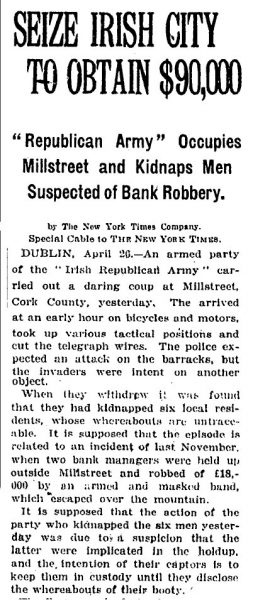
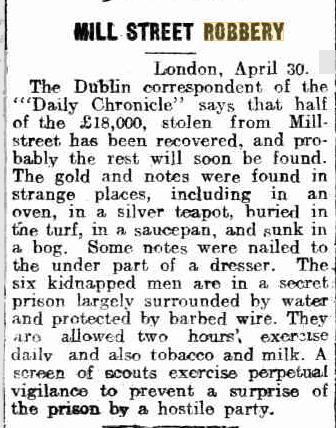
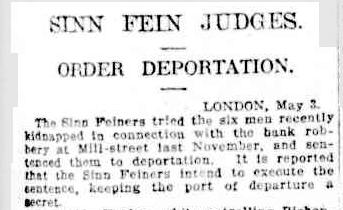
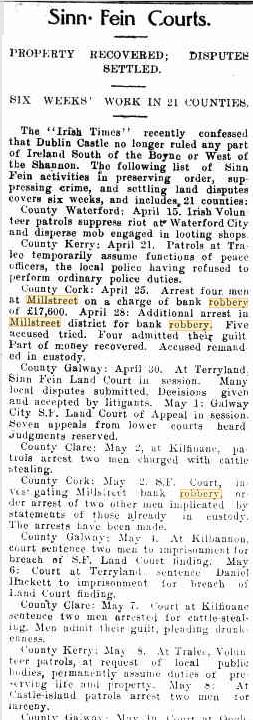
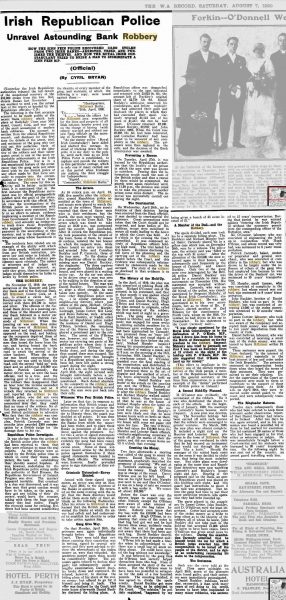
===============================================
The Skibbereen Eagle reported on the Robbery on November 22nd
BANK OFFICIALS “HELD UP DARING CRIMINALS” A sensational robbery Was committed within three miles of Millstreet on Monday when bank officials were held up and relieved of, it is believed , over £17,000. It was fair day in Knocknagree , and as is customary, officials from the Millstreet branches of the Munster and Leinster and National Banks left Millstreet in the morning for the fair, it being the practice of both banks to accommodate their customers in this way. Mr Gargan, accountant, and Mr O’Mahony, teller of the National Bank , left Millstreet on an outside car at 8 o’ clock. When they reached Ballydaly Cross five masked men, one of whom had a rifle and the others revolvers, dashed out from the bye-road which leads to the mountain, and covering the two ‘ bank officials and the jarvey demanded the money. Resistance was out of the question. – The three were “at once seized, bound and gagged and thrown over the fence, and the highwaymen took possession of the money. The horse was then unharnessed. Half an hour later, Mr Heffernan . Manager of the Munster and Leinster branch, and two clerks came along in a motor, and as they were approaching the cross the sidecar was dashed across the road and the motor ran into it. The occupants of the car, before they had recovered from the surprise which the collision had ensued, were surrounded by the party of robbers and ordered to hand over the money. Mr Heffarnan refused, but he was quickly overpowered, as were also the others, and they and the chauffeur were also robbed and taken inside the fence. The money having been seized, and the motor-car, as a means of conveyance, rendered useless , the raiders took the road for the mountain. Mr Heffernan was the first to extricate himself, and he then released, the others. They returned to Millstreet and reported the matter, and police and military were dispatched to the scene of the occurrence, but up to a late hour last night arrests though expected, had not been made. Great indignation was felt at Knocknagree, the fair, owing to tho absence of money, being practically held up, and in the evening a meeting was held at which the occurrence was denounced in vigorous terms. The exact amount taken is not yet known at the Cork offices, but it is believed that it must be between £16.000 and £20.000. Both banks were , due at Knocknagree at 9 o’clock, and their failure to hit in an apnearance and the subsequent news of the robbery caused consternation at their fair. It was a large fair, involving a turn-over of many thousands of pounds , and it was but natural that people who had sold their cattle and wanted money should be alarmed when it was learned that owing to the robbery the dealers would not be able to pay. The occurrence caused creat inconvenience to buyers and sellers, and indignation amonest the whole community. A Millstreet correspondent states:- Ballydaly Cross, about three miles from Millstreet, on the Killarney road , was the scene of a most daring highway robbery in the early forenoon of Monday. It has been the practice of both the officials of the National and Munster and Leinster Banks in Millstreet to attend the imoprtant monthly fairs of Knocknagree, where a large amount of business is transacted, and where both banks have offices for the convenience of their customers on fair days. On Monday morning Messrs Gargan and O’Mahony, accountant and teller respectively, of the Millstreet branch of the National Bank, left Millstreet on an outside car at about 8 o’ clock, for Knocknagree. On reaching Ballydaly Cross they were suddenly confronted bv six men wearing masks and armed with guns and revolvers. Before the officials were aware of what was taking place they were covered with guns and revolvers and relieved of their money. The party then unharnessed the horse, and one of the party bearing the money with him, rode off and returned againg after 60 time. Meanwhile the remainder of the party securely bound their prisoners including the driver, to trees, and awaited tha arrival of the Munster and Leinster Bank party. In the course of a half hour or so, Mr E V Heffernan, Manager, came along in a motor driven bv Mr P Carmody. The car on which the National Bank officials drove had been placed across the road as an obstruction, and on seeing this Mr Carmody pulled up. Both he and Mr Heffernan were at once covered, and on Mr. Heffernan refusing to hand over the cash he was struck with a revolver over the eye, and disabled for the time being, but the wound is not considered to be serious. Messrs Heffernan and Carmody were then seized, blindfolded and lic-und as their predecessors in misfortune had been. One of the robbers stood guard over the party and then decamped to join his fellows, who had already beat a hasty retreat. After some time Mr. Heffernan succeeded in struggling out of his bonds, and freed the others. They all promptly returned to Millstreet and reported the sensational affair. The affair has created the greatest sensation in the district, and it is unnecessary to add loud condemnation. The amount taken from the Banks is estimated at from £18,000 to £25,000
============================
ROBBERY UNDER ARMS
BANK OFFICIALS GAGGED AND BOUND TO TREES BY THE ROADSIDE
BANDITS GET AWAY WITH £19,000.
Daring highway robberies took place on Monday at Ballydaly Cross, about three miles from Millstreet, Co. Cork, where armed and masked men held up bank officials going to Knocknagree Fair, and decamped with from £17,000 to £19,000, books and documents. The circumstances recall the daylight robbery by masked and armed men in Cork about two months ago of a bag of money from Asylum officials, for which no one has been made amenable. [Wicklow People – Saturday 22 November 1919]
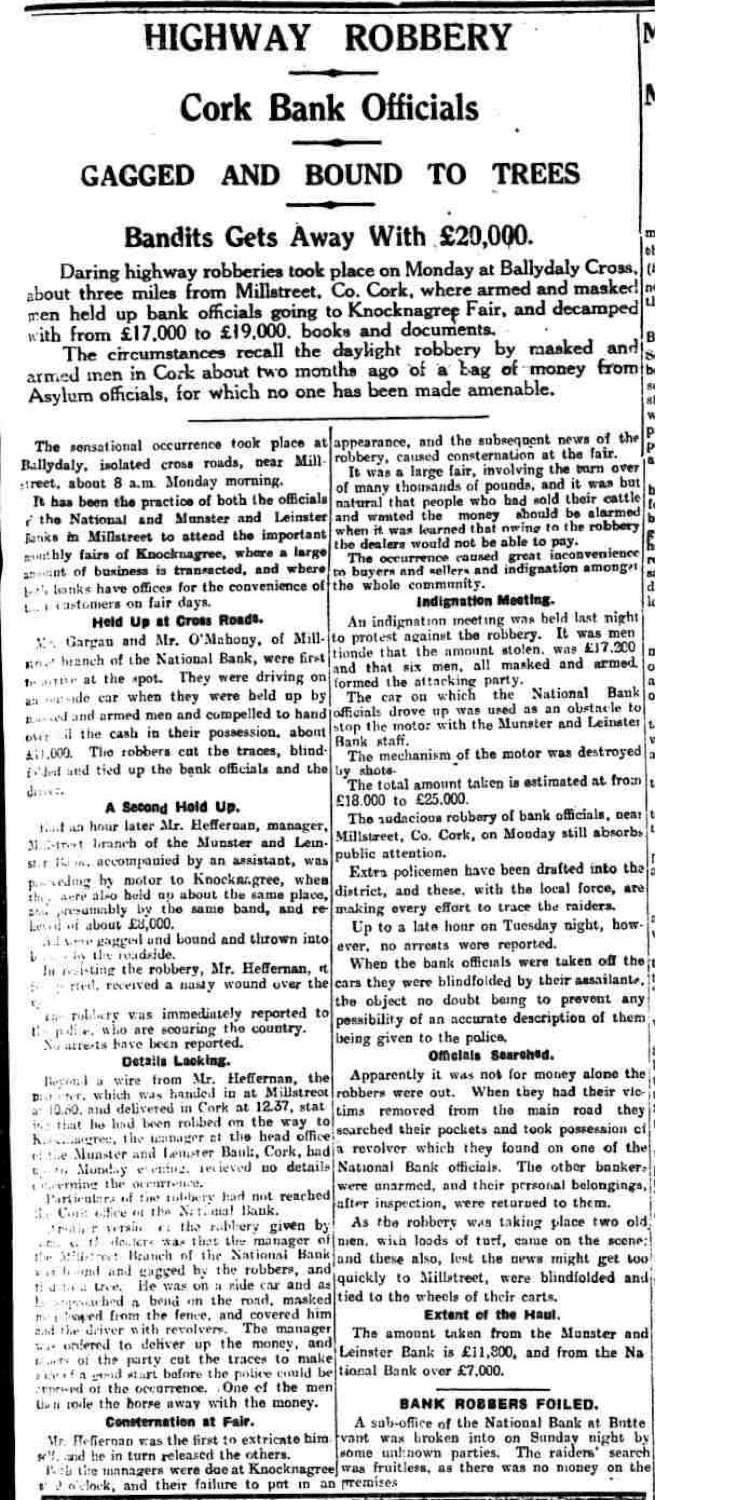 [Weekly Freeman – October 22nd 1919]
[Weekly Freeman – October 22nd 1919]
======================
Canon Breen denounces the Robbery from the Pulpit
… Rev. J. Breen, C.C.. Millstreet, speaking at Maas on Sunday, denounced the outrage on, and robbery of, bank officials last week, and tendered sympathy to the gentlemen. On Saturday, which was race day in Millstreet, the police warned shopkeepers against changing £5 and £10 notes without proper endorsal. [Irish Independent – Tuesday 25 November 1919]
=======================
 27th April 1920 Millstreet, Cork The recent arrest by Republican Police of 8 local men who were involved in last November’s armed robbery continues to cause intrigue in Cork. Reports now suggest that most of the stolen money will be returned to the banks from which it was robbed [1] (What paper?)
27th April 1920 Millstreet, Cork The recent arrest by Republican Police of 8 local men who were involved in last November’s armed robbery continues to cause intrigue in Cork. Reports now suggest that most of the stolen money will be returned to the banks from which it was robbed [1] (What paper?)
**********
Bank robbery 1919
Padraig O Caoimh in conversation with his friend Richard Mulcahy in 1964:
‘Do you remember when there was a bank robbery in November 1919? The two banks, that’s my place you know, my brother’s farm is there on the roadside- but in any case, the Munster and Leinster and the National Bank were bringing money to the Knocknagree Fair, which is eight miles from Millstreet, but they are all in the County Cork and they were going on the main road and they came to a certain crossing. They turned right to go in to the fair with the money- there was no law and order between yourselves and Mick Collins and the rest of the lads- these fellows robbed them and there was a terrible hullabaloo I needn’t tell you. There was no bloody fair. The farmers were going mad. Canon Breen- there were three Breens in it, Fr. Joe Breen in Millstreet, one was treaty and the others were irregular, of course you know Kate Breen well? Canon Breen sent for Roger Kiely, son of the master, and he sent for O’Reardon and he sent for Con Meaney and he sent for Jackeen Shine- a lot of them are alive yet mind you- he said to them tell me everything you hear, give it to me and tell nobody and keep your ears to the ground. That was November (1919). March was Fair Day in Millstreet- it’s a big Fair Day for five hundred years or more. Great horse country before the motor- I remember when the motor bike came in of course. There were four fellows in a pub in Millstreet in the evening between seven and eight o clock roughly and one fellow said he only got £1000 and another fellow said he only got £500 and that was all right and Roger was listening. He went out and he brought another fellow in with him and they had a drink- the other fellow was from Cullen. They reported that evening about nine o clock to Fr Breen in the presbytery – the old parish priest there was O’Laoire, he was eighty bloody years old and he wasn’t able to do anything- the Canon was doing everything. However, they watched themand one night didn’t they arrest the whole damn lot of them, the five of them and brought them down to Jackeen Tarrant’s house and tried them. They were told to leave the country at once. There was one fellow- he was a local fellow, Buckley but he joined the British army- he came back and they sent him away again. They sent him down to Cobh and put him on the boat, but he came back in any case and they took him and court martialled him and Canon Breen heard his confession and they shot him, they executed him. They got the money, but £500/£600 missing and Liam Lynch came up here with the Canon and he sent a message to me at No.6 (Harcourt Street, Sinn Fein HQ) and I went over to see him and he said what do you think we are up here with the money and the banks won’t take it, he said. The man who will handle that is Mick Collins, I said, we will have nothing to do with that at all, I said. God help you in every way, but he gave the money to Mick Collins’.
– from Some Relative History

